
Thank you! Your comment has been submitted successfully. You should be able to view your question/comment here within a few days.
Error submitting comment. Please try again momentarily.
- All Info
- Reviews (25)
- Q & A (0)
- Videos (2)
- Photos
Dexter Trailer Bearings Races Seals Caps - 31-73-3
- Bearings
- Standard Bearings
- 5200 lbs Axle
- 6000 lbs Axle
- 42 MM I.D.
- Bearing 31-73-3
- Dexter
Features:
- Designed for high-speed use
- 42MM ID Cartridge style, Nev-R-lube
- Fits Dexter 42mm Nev-R-Lube axle with 6-lug, 5-1/2 bolt circle
- Works on hub and drum assembly with drum size of 12 x 2
- Dimensions: 42mm I.D. x 76mm O.D. x 39mm wide
31-73-3 Dexter Axle Replacement Bearing JRM4249
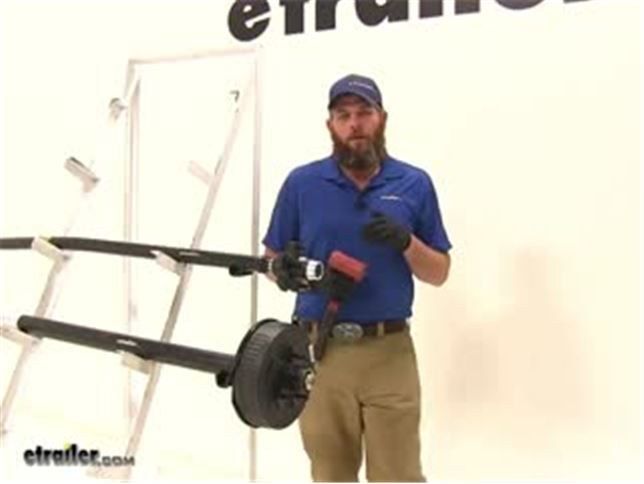

Videos are provided as a guide only. Refer to manufacturer installation instructions and specs for complete information.
Video Transcript for Trailer Bearings Races Seals and Caps Rebuild
Speaker 1: Today we're going to take you through the rebuild process on a couple of hubs. We've got an idler hub, and here we've got a hub and drum assembly. Works with electric rigs, but this can also work for just standard discs, if you've got a disc brake style setup.Basically what we're going to show you is how to get all of the bearings out. How to remove the seal. How to remove the race's if they're damaged, then get them replaced in the proper manner. We'll show you how to use an easy loop hub, which we have here.The first thing we are going to need to do is, get the grease cap off the end.
It can have either a rubber plug in it like this one does, or it can be a solid metal cap.These are pressed fit in there, basically by tapping on them on the back side. To remove them, a deadbolt hammer is typically what we're going to use. We're just going to start tapping as we go around. You'll see a little separation start right here, and slowly it'll work it's way off.Now the next step's going to vary a little bit depending on your axle setup. Do you see this is going to have a keeper that goes around the nut.
And that prevents that from being backed off, or removed. A lot of times you'll have a castle nut, which will have just little tabs that stick off, and there will be a cotter pin that passes through it. Just depending on your application, you need to get the keeper for the nut off. This style we just kind of pry out. A cotter pin you would just remove of course.Once we have that off ...
We'll start to take off the nut here, and the washer that's in behind it. Now yours should look a whole lot more dirty than this. There should be a lot of grease packed in, and through the hub, this one's brand new. We thought it'd be nice to show you the components before the grease was on .. Of our washer that comes off.And then here we're going to have our outer bearing.
Continue to pull that. We're gonig to have our inner bearing here. That sits in the backside of the hub. And we didn't put it in yet, we will show you how to put it in. But a seal would typically be covering the backside here. We'll show you how to use a seal removal tool, or another tool. To get that pried up and out. To get an access to that inner bearing.Now for a drum style like this, that process for disassembly is going to be just the same. One thing to keep in mind if you're using a disc brake setup. You'll have to remove the caliper before the disc is going to come off.Now once we have the spindle exposed, as we said this is going to be really greasy. We want to get all the grease removed, and the first thing we'll do is inspect it. We want to make sure that it looks just like what we have here. Everything's nice and smooth. We don't see any kind of discoloration, or any marring on the metal. Indicating that our bearing's got hot.If you do have any of those symptoms, at this point it's time to replace those bearings. You don't want to repack them. Get new bearings, and put in there. You might have a bearing that's come apart in here. Another surface to ensure is in good condition, is where your seal is going to go. That helps seal all the grease inside of our hub. With a damaged or broken seal, that grease is going to seep out. Either out of the hub, or in this case into our brake assembly.Now if your axle has brakes, we're also going to check the disc. Make sure it doesn't have any issues, or your hub. And this is going to be a hub and drum assembly. The brakes are going to ride on this machine surface. You're going to check that for signs of excessive heat, discoloration, or cracking. And this is our magnet surface. We'll check that surface for the same issues.Now inside the hub regardless if it's a disc brake, it's a drum brake like this. Or just a standard idler style hub. You're going to have an outer race. Would be right here, it's a small tapered piece of metal your bearing sits in, and rotates on. That's basically the outer portion of the bearing.You have the same thing here on the backside. This is called the inner race. Now if those show any signs of wear, overheating, or cracking. Those are also something we'll need to replace, which we'll show you how to do in just a minute.Now, with your brake assembly exposed, if you do have electric brakes like we have here. It's a good idea to check all the components for wear, cracking, maybe missing pieces. Check your pad thickness to make sure those are in good shape. Basically if you have a non working brake assembly and you put everything back together, you're just going to have to take it apart and do it all over again to get back to the brake assembly. This gives you a really good option to be able to change them out.And most applications are going to use a four, or maybe a five bolt flange to hold them in place. And you'll just remove the lock nuts, or sometimes you'll have a hex nut with a lock washer. You want to remove those, and then simply slide your assembly off after you cut the wiring.The friction material itself should also be checked for any kinds of cracking, or overheating. If you have any grease inside the system at all, it's likely it's gotten on those pads. It's a good idea to get those changed. Now as far as the removal of the races go, it's going to be just the same whether we're using an idler style hub like we have here. A drum brake like we have here. You can basically see where the idler is, here in the middle of the hub. It's going to go all the way around there, and we just have this extra material here to provide our braking surface.Now if you're doing a disc brake style job again, it's going to be just the same here with the races living inside of the actual hub portion. You'll just have the discs there for the brakes to make contact. We're going to use this little bit smaller one, it's a little bit easier to manage to show you how to get these out. We've talked about where the races are. The outer here, the inner being closer to the inside, but on the backside of the race there's a little lip. That lip's meant to stick out just a little bit further than the hub, and provide us an area to put our tool on, and help to drive that out.If you look all the way through there on that inner race, you'll see that little lip that sticks out just from the hub slightly, and it gives us enough area to use our tool on. Now generally to remove these you're going to use a punch, similar to this. Some guys will use a screwdriver. Or a piece of pipe. If you have a piece of pipe that's small enough to fit inside of that diameter, you can take that down through and allow it to rest on that lip.Use our punch, and then just need a hammer. And we'll start working that out. We're going to tap all the way around. Kind of equally, and evenly apply the force to get it to come on out of the bottom for us.You can see now as it starts to come out there's going to be a little gap created between the hub and the race. And we can just keep going, bringing it on out. Then you can inspect the inside of the hub surface there. Make sure no damage or anything has occurred, and repeat that same process for the outer race if you plan on removing and replacing that one.Now in the outer flat edge, you can see we're going to have our tapered edge on this side. If we roll our race over to the flat side, typically there's going to be a manufacturers part number on there. That will help you identify which race it is, that you need to go back in your system. If those are rubbed off, worn off, if you can't read them. You can measure the outside, to outside diameter of the race here. It's a good idea to use a micrometer to get it exact.Now here's your basic micrometer. And again, the outside of the race is what we're going to need to measure. You want to go . I set the thickest point there. Looks like this one's going to be about 1.98. That's going to be the measurement you'll want to supply.Now while we've got this out, let's also look at the proper way to measure our bearing. Instead of the outside for the bearing, we need to measure the inside diameter. That's going to be pretty simple. Let's pull that out, find the largest measurement we can. Which here, looks like it's going to be 1.03. With that information, we'll be able to get the correct bearing, and the correct race, so they'll fit together properly and make a full bearing kit for us.Now here's the race, we're going to show you how to get this put back in. Basically just going to press fit inside of our hubs. We need to get it down on there. Kind of like that. And you'll have a couple options. A lot of times you're going to see do it yourself or at homer, just going to use a wooden block. Just place it on there. That's going to get you started, but at that point you'll struggle in getting it to go all the way down into it's seat.Now to take care of that problem, there are several seal drivers that are available. Seal and race drivers that are available out there on the market. It's designed to fit down inside of our race, inside of our hub and get it down there where it needs to go. This is part number ptw83020, has several different sizes, even if you have multiple trailers it's going to do the job.Now the side with the angle on it, is designed to fit down inside of our race. If we use the other side, that's going to be for driving your seal into place. Just want to hold it, and take it on in with your hammer. You'll see, you just want to insure that our race is all the way up against that line on the hub where it's supposed to mate to.Now when it comes time to pack your bearings you're going to have several different ways of doing this. You can just use your hand, is the traditional method. That's going to be the method probably reserved for the very occasional trailer work kind of situation. If you do it once or twice a year, probably get away with it that way.Next you would go to a, kind of a sandwich funnel style almost. If you look inside of there, you can see the bearing. It's located between the two pieces. Just use a grease gun. Start filling that with grease, and that's going to fill our bearing for us. And the third, with this one you're just going to place your bearing down and in. It should be pretty close to center. And then we've got our cone her that's going to go down and secure that.Now I think this style, wastes a little bit more grease than what this style will. This has a dust cap. You can see, you can keep your grease in there, put your dust cap on there and save it for later use. This will be if your going to do it every couple years. And this particular style would be if you're a more regular user.Let's start by showing you how to use a bearing packer. Similar to this. Again, we've just got our grease inaudible 00:11:07 here on the top. And then just slowly start to fill it. Now I like this style quite a bit. I think even regular users might enjoy it, because you can get a really quick visual look at that bearing. You're not going to have to overdo it, or have to much grease.You can kind of see in there now, we're starting to get grease to come out of it. Couple more pumps, we'll be good. You can see we've got grease coming out all the way around. Where all of our bearings are. Got a little bit of excess there. Just take that around the outside of it. And then we should be able to lift it off. And now you can see what we we're talking about. Just a little bit of excess there, that you're just going to wind up wasting.Now we'll take our bearing, we're going to place it right down in our race. And then we'll cap off the back with our seal. Right now our seal's going to fit in just like our race did. It's going to have a little bit of a pressure fit to it. Now very often in this situation, I see people using the four by four method. Kind of here, just placing that on and tapping it. As an option though, if you do have one of these. You can see that's designed to fit right on the top of the seal. And help drive it in.The biggest thing here is, just going to be getting it driven in squarely. You can see, this side's in a little bit further than this side. I'm going to start this side first. Now since we didn't have the opportunity to show you before, we're going to take a look at pulling a seal. Now this is a seal puller, we carry this on our website part number ptw1219. This is meant to hook underneath the seal. And then you kind of pull up on it, and just like our race you'll have to work all the way around that edge. Just bringing it out a little at a time.If you don't have that available. Another option would be a screwdriver. You just kind of get that under the seal, and turn it. And see, that'll allow you to also pop that out. We've taken care of our race. Our inner bearing. Our seal. The last component, before we put our hub back in place is going to be our outer bearing. Now with this bearing, I'll show you the hand packing method.This is definitely . Slightly dirtier method than the bearing packer. When we get grease on our hand we want to look at the larger side of the bearing. This is the smaller side. We have a larger side In between the inside and outside there's a gap. We can see our rollers in there. We want to grab that, and use that gap and shove grease inside of it. Now this is going to take a little bit, you want to work in the same spot until you get the grease pushed all the way through. We can see on the top there we've got a little bit starting to come through.And once we push it in the bottom, and you see it start coming out the of the top in those little drips, it's going to indicate that, that section's fully packed. Just need to work all the way around their outside edge now and do the same thing. Alright, once that's all the way around . The bearing will be ready for use.Now one more thing I like to do. We can see our inner bearing there, and our outer bearing. Well between the two, got a pretty big gap in there. If you'll take a . Pretty good amount of grease. We're just going to go all the way around. See how we can go all the way around the inside and just line that really well. The more grease we have in here, the less chance we have of any moisture getting in there, which can cause corrosion, rust, pitting. Pretty much things we do not like when it comes to bearings, races, and hubs.Put plenty of grease in there. And then this one does have the easy lube spindle, that'll even fill it in more. Now we can get our assembly slid on. I like to keep my thumbs on that outer bearing, just to prevent it from . inaudible 00:15:28 pushed off there. Now we can put on the original hardware that we removed, in taking off our hub the first time. In our case, we had our washer and our nut.Now most commonly you'll see pliers similar to this being used. We basically want to get that tightened down. Once it's fully tightened down you'll feel some resistance in the hub. We back it off just slightly. That'll give us a little bit more freedom of motion there. Something you don't want however . Is any movement in, or out on your hub. You want to be sure that everything is compressed, and you don't have what's called end play. Which would be the play in and out.Once we've got that set, then you'll put on whatever tight keeper yours came with. Get that put back in place. Now with an easy lube style hub, you're going to place your grease gun on the end, and then you can just fill the remainder of that hub up.Now for your typical applications, you're either going to have a solid cap, or a cap that'll have a rubber plug in it. A solid cap's going to be for an axle without the grease inaudible 00:16:51 here on the end. Goes on there. Just knock it on with your rubber mallet. Same with the one with the plug. Just gives you a removable area there, be able to cap that off.We'll show you how to put that on. Now as alternatives as well, a lot of times on boat trailers and marine kind of situations. You'll see a bearing buddy. This is going to apply a little bit of pressure on the grease, you'll fill it up. This kind of comes out just a little bit. That applies constant pressure on the grease to make sure we don't have any air, or anything like that. Then there is also an oil bath hub available. Now this is going to be for use with seals that are going to be designed specifically for oil bath use. You'll have to change that seal.We're using a double lip seal. There are also single lip seals available. Of course a double lip seal is going to give you just a little additional security. Keep that in mind when you order. But let's get this knocked on there now so you can see how that works. We just want to take the cap, we're going to center it. This is going to be very similar to what we did with the seal. And then just gently start tapping it around the outside. And it'll seep down on there for you.It's really going to be the same thing that you'll do with any of the end caps. Now with this side done, it's a good idea to take care of all the other hubs. Get them all on the same maintenance schedule. And as long as you'll periodically check the grease, take your trailer out for a trip occasionally. Just to keep everything lubricated. It should extend the life of these parts, and give us years of good service.
Customer Satisfaction Score:
95% were satisfied with this product
5% of customers were not satisfied
- Product did not meet expectations
- Wrong item was ordered
- Arrived Damaged
Customer Reviews
Bearing, 42MM Nev-R-Lube 42MM x 76MM x 39MM - 31-73-3
Average Customer Rating: 4.6 out of 5 stars (25 Customer Reviews)
Very good quality-low maintenance- airstream trailer use this bearing- had to replace due to submerging in flood water for 2 weeks
I received my nev-r-lube bearing in about a week. Exactly what I ordered. I have ordered numerous items for my camper from e-trailer and have always been satisfied. Thank you
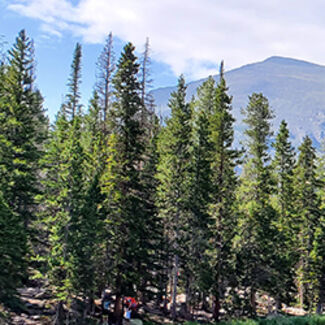
Dewayne

1/31/2021
Yes, I don’t know why they don’t put Nev-R-Lube bearings on all Camper.
as usual it is always better than great it is fantastic. Have a good day.
etrailer has always provided excellent service to me. I buy almost all of my trailer parts through them, and if I need help with replacing any parts, they have lots of videos on how to do the job. I highly recommend them for your trailer parts needs.
Tim
My bearing arrived in a reasonable amount of time and it was the correct one. I do have one complaint however, I purchased the same bearing in 2017 to carry as a spare. I needed to change a bearing when doing routine maintenance, when I opened the NEW 2017 purchased bearing it came apart in my hand. Etrailer management elected not to replace the bearing due to my purchase date! I contend I was sold a defective bearing by them and I had the invoice and order number to back it up but I was told to contact Dexter Axel because that was where they purchased the bearing! Management needs to take a look at their customer service plan.
Could not find the rv never lube bearing assemble any place in houston TX. except online at the e trailer site. Very happy. Was stranded at rv park in houston tx, now I can go to florida for the winter and Minnesota in the spring.
Thanks for the fast shipment. Dz
Awesome assistance from Paula with the order and matching competitive pricing. Products were delivered in two days, freight included. Double awesome. Purchased these brake assemblies and bearing for backup on long road trip with our Airstream,
and hope I don't need them. Can't beat the professionalism and attention to detail of ETRAILER!!!!!!!!!!!
Dave
Cloudland GA
It took some work and time to figure out what bearing I needed for me airstream trailer but once I ordered it the shipping was immediate and it was delivered on a Sunday

The bearing was as described, it fit my application, it worked just fine, and it’s still working.
Etrailer is my new go to supplier for horse trailer parts. They shipped the same day I ordered and delivered two days later.
Alls good! Fast delivery!
Etrailer service, dependability, shipping and followup after the sale are absolutely the best
This item was shipped and received within days of ordering it

+Just what I needed
Good good good
See what our Experts say about this Dexter Trailer Bearings Races Seals Caps
- Is Dexter Bearing # 31-73-3 Made by Timken in USAYes, the Dexter Nev-R-Lube bearing part # 31-73-3 that you referenced is made by Timken in the USA.
view full answer... - Replacement Nev-R-Lube 6k Trailer Hub BearingThe Dexter Nev-R-Lube 6k hubs use 42 mm bearings so the correct replacement is the part # 31-73-3.
view full answer... - Will the 42mm Nev-R-Lube Bearing Fit Dexter 6,000 Pound Axles on a 5th Wheel Trailer It is not likely but still possible that the 42MM Nev-R-Lube bearing # 31-73-3 would fit your 6K Dexter axles and hubs. These bearings are specifically designed to fit Dexter Nev-R-Lube axles which are not all that common. You can check the outer bearing number without removing the hub from the trailer (you will probably have to wipe away some grease). If the outer bearing is any of the following then the Nev-R-Lube bearing will definitely not fit: 14125A 15123 506849 LM67048
view full answer... - Can Nev-R-Lube Bearings Spin in Either DirectionYou are correct, the Nev-R-Lube bearings like the # 31-73-3 that you have are not directional. They can rotate in either direction and work perfectly fine.
view full answer... - Where is Dexter Bearing 31-73-3 Made & Is It TimkenWe went ahead and took a look for you at the Dexter Bearing, 42MM Nev-R-Lube 42MM x 76MM x 39MM # 31-73-3. I can tell you that what we have is indeed a Timken product that is made in the USA; it says so right on the bearing. I have added a link below to a video review for you to check out as well of the Dexter Bearing, 42MM Nev-R-Lube 42MM x 76MM x 39MM # 31-73-3.
view full answer... - Torque For Nev-R-Lube NutWhen installing a bearing like the Bearing, 42MM Nev-R-Lube 42MM x 76MM x 39MM # 31-73-3 the nut should be torqued to 145-155 ft. lbs.
view full answer... - Nev-R-Lube Trailer Bearings Cannot be Replaced with Regular BearingsNo, the problem is that the Nev-R-Lube bearings are uniquely sized to fit the compatible Nev-R-Lube hubs. That is partially why the sizes are given in metric units rather than inches. Because of the incompatibility with regular bearings in order to use something different you would need to change the spindles on the axle which pretty much means that the axle has to be replaced. Considering the cost of Nev-R-Lube bearings the cost of an axle is not all that much more but increases when...
view full answer... - Replacement Bearings and Seals Needed for a 1989 Escort Single Axle Boat TrailerI did some research and found some information that you may find helpful, but to determine the correct parts for replacing the bearings and seals on your Escort boat trailer axle, you will need to remove one of the hubs and get the part numbers off of the inner and outer bearings and seal. The bearing part numbers are usually etched into the back of the bearings and the seal part number is usually embossed in the rubber portion of the seal. Escort does not list axle capacity or bearings...
view full answer... - Replacement Nev-R-Lube Bearings for 8 on 6-1/2 Inch Bolt Pattern on 2001 Sooner Royale Horse TrailerYour bolt pattern of 8 on 6-1/2 is a huge help. You will want the 50MM Nev-R-Lube Bearing for 8,000-lb Dexter Axles - Qty 1 # 31-71-3. The 42MM Nev-R-Lube 42MM x 76MM x 39MM # 31-73-3 is only a fit for 6 on 5-1/2 inch bolt patterns, and the 35MM Nev-R-Lube 35MM X 64MM X 37MM # 31-72-3 is also for smaller axles. The mm measurements mess with some people, so the 50mm bearings will be 1.968 inches, the 42mm will be 1.653 inches, and the 35mm will be 1.377 inches.
view full answer... - Sealed Bearing Replacement For National TrailerWe offer three sealed bearings so you will need to take some measurements to see if they will work for you. If one of these matches the dimensions of the bearings you have then you can use it as a spare. Our Redline Nev-R-lube Bearing # 31-73-3 measures 42mm I.D. x 76mm O.D. x 39mm wide. For Bearing # 31-71-3, the measurements are 50mm I.D. x 84mm O.D. x 54mm wide, and bearing # 31-72-3 has a measurement of 35mm I.D. x 64mm O.D. x 37mm wide.
view full answer... - How To Choose Correct Replacement Dexter Nev-R-Lube BearingsWe currently offer the Dexter Nev-R-Lube Bearings in a few different sizes, 35MM part # 31-72-3, 42MM part # 31-73-3, or 50MM part # 31-71-3. Please note, these are referring to the inner diameter of the bearing. In order to find the correct one you can either pull apart the hub and measure, reach out to the axle manufacturer with the serial number, or call the trailer dealer. If you would like, I can reach out to the axle manufacturer for you if you provide the serial number. I cannot...
view full answer... - How Often Should I Inspect Sealed Bearings On A Boat TrailerYou may have sealed bearings on the boat trailer like Dexter 35MM Nev-R-Lube part # 31-72-3, Dexter 42MM Nev-R-Lube part # 31-73-3 or Dexter 50MM Nev-R-Lube Bearing part # 31-71-3. The sealed bearings are typically considered maintenance free because they are pre-greased at the factory and they are sealed which makes them resistant to contamination. Even though the bearings are already greased, it is a good idea to pull the hub off once a year to check for damage especially since the...
view full answer... - How to Pick Out Nev-R-Lube Bearings for a Carriage Cameo 5th Wheel TrailerIn order to pick out the correct Nev-R-Lube bearings for your Carriage Cameo 5th Wheel trailer you will need to pull your hub to get the numbers off of your bearings or get the diameter of your spindle. If your have a 42 millimeter spindle then you would want the # 31-73-3 bearing you referenced, 35 mm spindle you would want the # 31-72-3 or 50 mm # 31-71-3.
view full answer... - Which Dexter Nev-R-Lube Replacement Bearings You'd measure the diameter of the existing nev-r-lube bearing to find the proper replacement. We offer the # 31-71-3 50mm for 8K axles, the # 31-73-3 42mm for 3.5 or 4K axles and the # 31-72-3 35mm for 3.5K axles.
view full answer... - Sealed Trailer Bearing AvailabilityWe have a few sealed trailer bearings. If you have a Neverlube bearing setup on your trailer then you would want the # 31-72-3 for a 35 mm bearing, #31-73-3 for 42 mm, or # 31-71-3 for 50 mm. The measurement that I mentioned for each bearing would be the inner diameter.
view full answer... - How Often Do Trailer Wheel Bearings Need to be GreasedStandard tapered trailer wheel bearings are recommended to be re-packed with fresh bearing grease about every year or every 12,000 miles under normal use. In certain conditions this interval could be shorter, such as if you routinely tow the trailer under conditions of extreme heat or near its maximum load capacity. This and other recommended trailer maintenance procedures are outlined in the linked article, which may interest you. I also linked an article that provides an overview of...
view full answer... - Does Dexter Nev-R-Lube Bearing Installation Require Using A PressThe 42MM Nev-R-Lube bearing # 31-73-3 is designed to fit Dexter Nev-R-lube axles that have a hub with a 6-lug, 5-1/2 bolt circle. I called my contact at Dexter and they told me you do not have to press the bearing in place when installing. You can use a dowel to tap it into place so that you do not damage the bearing when installing. With this bearing, everything is there and you do not have to worry about seals, races or repacking the bearings. This bearing is designed to give you...
view full answer... - Repacking Bearings on a 2004 Fleetwood Yuma Pop-UpOn your pop-up trailer it would be very unlikely that you have cartridge bearing. To see what they look like check out the part # 31-73-3. Most likely you have standard bearings. Which the FAQ article I attached to the right would walk you through everything you would need to do.
view full answer... - Determining Correct Nev-R-Lube BearingToo determine the correct Nev-R-Lube bearing, use a digital caliper like # PTW80157 to measure the inside and outside diameter of the bearing. We offer the following: - 42mm Inside Diameter x 76mm Outside Diameter: Bearing # 31-73-3
view full answer... - How to Determine Correct Nev-R-Lube Bearing/Hub AssemblyFrom the pictures you sent in it looks like the inner diameter of your Nev-R-Lube bearing is about 2" which means you'd need the 50MM Nev-R-Lube Bearing for 8,000-lb Dexter Axles # 31-71-3. Aside from that you're basically just going to need to pull that bearing and measure the inside diameter to determine if the 50MM # 31-71-3, 42MM # 31-73-3, or 35MM # 31-72-3 bearing will best fit. The part 008-402-81 that you referenced finding somewhere else looks to be a hub assembly for a disc brake...
view full answer... - Availability of Dexter Nev-R-Lube Cartridge-Style Wheel BearingsA tandem axle travel trailer such as the Airstream Flying Cloud 27FB will require four sets of wheel bearings, an inner and outer bearing for each hub. Based on this trailer's GVWR it is likely to have two 3500-lb-rated axles. Often axles of this weight capacity use standard tapered roller bearings # L68149 (inner) and # L44649 (outer). Dexter Nev-R-Lube cartridge-style wheel bearings like # 31-71-3 are offered in millimeter sizes; this one is 50mm. 42mm and 35mm sizes are also available,...
view full answer... - Nev-R-Lube Bearings and Self-adjusting 12 x 2 Electric Brakes for 2012 Airstream 27FBBased on the axle serial number you provided my contact at Dexter Axle confirmed the Nev-R-Lube bearings you need are the 42mm size, part # 31-73-3. You will need one bearing per hub. For brakes my contact confirmed you need 12 x 2-inch self-adjusting electric drum brakes # AKEBRK-7-SA, one kit per axle.
view full answer... - Is Dexter Trailer Hub & Drum Assembly Sold IndividuallyNot a stupid question at all. The Dexter Trailer Hub & Drum Assembly, part # 8-388-80UC3 is sold individually. If you find that down the road the inside of the drum is scored it can be resurfaced. The cartridge bearing for this assembly is part # 31-73-3. There is only one bearing for this hub and drum.
view full answer... - Needing a Never Lube Bearing for Dexter 6000 Lbs Trailer AxleThe Redline Bearing # 31-73-3 is a cartridge style Never-Lube bearing that fits 42mm Dexter Never-Lube axle with 6 lug on 5-1/2 inch hubs with 3,000 lbs capacity like # 8-388-80UC3. This bearing complete dimension are 42mm I.D. x 76mm O.D. x 39mm wide.
view full answer...
Do you have a question about this Trailer Bearings Races Seals Cap?
Info for this part was:









At etrailer.com we provide the best information available about the products we sell. We take the quality of our information seriously so that you can get the right part the first time. Let us know if anything is missing or if you have any questions.




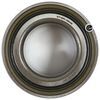







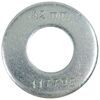



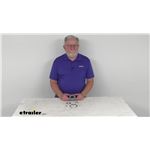





































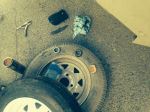
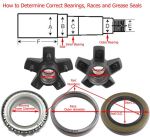
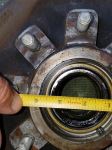

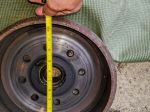
James
11/12/2023
All good so far